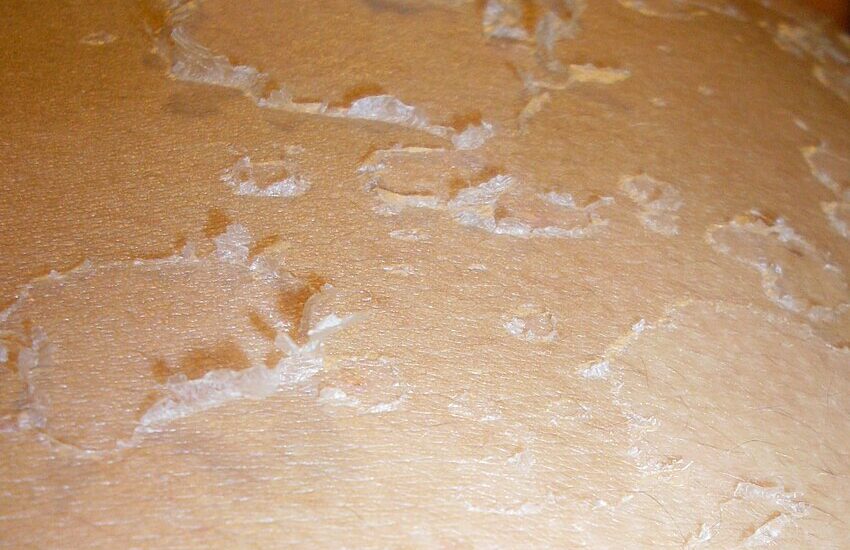Is your skin peeling after fungal infection? This comprehensive guide will provide you with actionable steps for treatment and recovery.

Table of Contents
What Causes Skin Peeling After Fungal Infection?
The phenomenon of skin peeling after fungal infection occurs due to a combination of factors that affect the skin’s integrity. When you get a fungal infection, the fungi compromise the skin’s natural barrier function. As your immune system fights the fungi, inflammatory responses such as redness, itchiness, and peeling occur. (Source)
Specifically, the infection triggers the skin to regenerate new cells faster than normal. As new skin cells push to the surface, the old, infected ones are sloughed off, causing the appearance of peeling skin. This is a natural mechanism to help rid the body of the infection.
The types of fungi that are commonly responsible for skin infections include Candida and Tinea species. The disrupted skin structure due to the infection, coupled with the body’s response to fight it off, leads to the symptom of peeling skin.
Do Fungal Infections Peel When Healing?
It is a common misconception that skin peeling after fungal infection is always a sign of worsening conditions. In the context of fungal infections, peeling is generally a positive sign indicating that the skin is undergoing a renewal process. Dead skin cells are shed and replaced by new ones in a process known as exfoliation.
This shedding is particularly noticeable during the healing phase after you have begun treating the fungal infection with antifungal medication. So, while it may look alarming, skin peeling can actually be a sign that the infection is resolving. However, the duration and extent of peeling can vary from person to person. If the peeling persists or becomes severe, consulting a healthcare provider is crucial.
Can Candida Cause Peeling Skin?
Candida is a specific type of yeast, a form of fungus, that is known to cause various skin conditions. When Candida infects the skin, it disrupts the skin’s natural pH balance and moisture levels. This disruption causes inflammation and can lead to symptoms such as itchiness, redness, and notably, peeling skin.
Candida-related skin infections include conditions like athlete’s foot, yeast diaper rash in infants, and oral thrush. Each of these conditions can manifest with skin peeling, either during the active phase of the infection or during the healing process. Therefore, if you notice skin peeling in the context of a Candida infection, it is a common symptom.
How to Treat Skin Peeling After Fungal Infection
How to treat skin peeling after fungal infection involves both medication and proper skincare. Your healthcare provider will likely prescribe antifungal creams or oral medications specifically designed to kill the causative fungal organisms. The medication works by targeting the cell wall of the fungi, causing them to die, which initiates the healing process.
Alongside medical treatment, maintaining a gentle skincare routine is crucial. Use a mild, fragrance-free soap to avoid further irritation.
Keeping the skin moisturized can help alleviate dryness that contributes to peeling. Use a hypoallergenic, non-greasy moisturizer, ideally one that contains ceramides, which help restore the skin’s natural barrier. The CeraVe Moisturizing Cream listed on Amazon is a good example.
Avoid scrubbing the affected area, as this can exacerbate peeling and irritation. Always follow the treatment guidelines provided by your healthcare provider, and if you notice no improvement or worsening of symptoms, seek further medical advice.
Check out these other articles…
Can Fungal Infection Cause Skin Discoloration? Answered
Dry Skin After Fungal Infection: How to Heal & Prevent
Red Skin After Fungal Infection: 3 Causes & Sure Solutions
How Long Does Fungal Infection on Skin Last? Complete Guide
Can Fungal Infection Cause Skin Rash? – Unraveling the Truth
When to Seek Professional Help
If you notice that the peeling is severe, persistent, or accompanied by other symptoms such as pain or bleeding, it’s crucial to seek professional medical advice as soon as possible. In rare instances, persistent skin peeling could be an indication of underlying health issues or complications related to the fungal infection, which may require specialized treatment.

